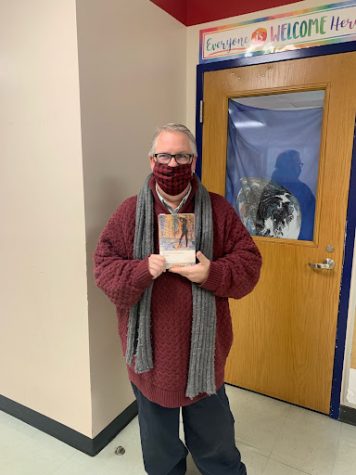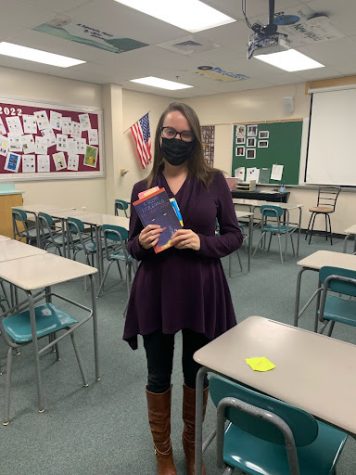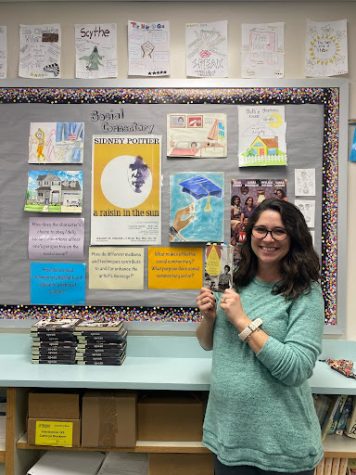Literature Meets Learning
From the beginning of freshman year to the very last days of senior year, students are constantly introduced to memorable works of literature. They walk alongside relatable characters and place themselves within historical settings. Teachers play the most important role in making these stories come to life for their students. Ranging from the dystopian world of Fahrenheit 451 to the royal palace of Hamlet, English teachers’ favorite books and plays to teach vary across grades.
Mr. VanWestervelt

Russell VanWestervelt, one of Centennial’s senior English teachers, favors a classic high school English reading, Hamlet, by William Shakespeare. He mentioned his favoritism toward the characters, “I think students can really relate to them. I know I could relate to them when I was a high school senior.”
Acting out the book is a favorite classroom activity, along with sketching out the characters to see each student’s unique interpretation of what they think the characters look like.
Finding meaning and relatability in the characters is definitely a key point to keeping students interested. “I think it’s important, no matter what book you’re teaching, that students can relate to some of the character traits, and they can maybe identify what the character was feeling,” he stated. “Even if there’s an age gap and even if there’s a 400 year gap of the text being written, it’s universal, it’s timeless.”
As well as keeping students interested, he wants the lessons and the books to be memorable enough for students to be able to continue learning from the characters throughout their careers. “What I really hope is that they find something they like about it that’s bigger than an assignment or a grade, that they can take with them long after they leave high school,” he said. “Not just that they had it as an assignment but they can relate to a character, and then they can say, ‘Maybe I can relate to other characters in other books too.’”
As VanWestervelt puts it, Hamlet would definitely have some valuable advice to give to Centennial students; “‘I get it that you’re emotional and dramatic, don’t always act on those emotions and the dramatic way you feel, because you’ll end up like me.’”
Mrs. Morris

Mary Pat Morris, who teaches juniors during third period, mentioned the 1925 novel, The Great Gatsby, written by F. Scott Fitzgerald, as her top choice.
As Morris reasoned, “We do a lot with color, imagery, and symbolism, so that’s what I like about it: the depth of the elements we can talk about.”
With American literature, novels can be directly applied to various subjects and provide a glimpse into American history as a whole. During their junior years, many students take AP US History, which adds rich historical context to the books they read in English.
Specifically, The Great Gatsby is a reflection of wealth and the American Dream; “You really look at the time period of the 1920s and how it’s shown in the novels,” Morris explained. “And you also look at the elements of Modernism, which is the literary era tied to it, so I feel like some of the connections you can make are what make it an interesting study.”
When it comes to student engagement, Morris mentioned that The Great Gatsby is typically popular because “there is a little bit of suspense and tension building up to it, so it keeps people interested. The depth of the characters, whether you like them or don’t like them, is intriguing.”
Especially with this novel, the characters are particularly complex and all represent an aspect of a corrupt American society– it’s difficult to come up with helpful advice for students through the characters of The Great Gatsby. Rather, “Fitzgerald might say to use some of the stories of the characters as a cautionary tale,” Morris said.
Mr. O’Brien

Corey O’Brien, Centennial’s 2020-21 teacher of the year, couldn’t choose just one of his favorites. One of his choices is Fahrenheit 451 by Ray Brabury, a textbook staple for high school literature.
Taught in the sophomore dystopian unit, Fahrenheit is “a book about the need to think,” as O’Brien put it.
“There’s just a thing about some of the passages in Fahrenheit that are so acute and poignant about life,” he stated, embracing the timelessness of the lessons and overall storylines. “There are either images or ideas that are being communicated that just continue to provoke, you know 20 years doing it.”
Also taught in the dystopian unit, his other favorite, In the Time of the Butterflies by Julia Alvarez, is historical fiction based on a true story. His favorite part of this book is the relationships between the characters. “I feel like I know the women that the books are about and they’re based on real people.”
Timelessness in lessons is another plus to the unit, as “It transformed me reading the book, then it transformed me even more planning on reading the book, and then it transformed me even more teaching it and learning it together,” he mentioned.
Fahrenheit 451 is more dystopian, but that doesn’t mean that it can’t have true life lessons. “I feel like we innovate in this world ways to live better, and what we think that means for some people is to make things easier, and I don’t think that’s true,” he added. “Fahrenheit is all about thinking and thinking hurts.”
In In the Time of the Butterflies, he enjoys the lessons that are specific to the story; “the world can be better, and [the characters] don’t rely on some power above to make it better, you have to, and make it work.”
While they’re two different genres, Fahrenheit 451 and In the Time of the Butterflies both have similar life lessons weaved into their storylines. “We have a skewed sense of what improvement means and I think both those books try to encourage us to lean into the heavy load. Life is heavy,” O’Brien added.
Advice O’Brien took from Fahrenheit’s characters that he wishes to pass on to students and teachers alike comes from the protagonist, Montag’s, point of view. “You need each other, despite your disagreements, you need each other. Even people who you think are on the other side, we need each other in order to make this work. To be your individual self, you need community.”
Ms. Beckner

Another exemplar written work that provides social commentary on the ideals of the American Dream is A Raisin in the Sun, a play written by Lorraine Hansberry. Cate Beckner, an English teacher for the freshman class, embraces the timelessness of her favorite work to teach.
“It has a lot to do with our society, issues in our society, and even though it takes place in the 1950s, a lot of these issues that come up in Raisin are still really relevant and at the forefront of our society. Current society,” emphasized Beckner.
With A Raisin in the Sun, Beckner annually assigns a project called the “American Dream versus American Reality,” where students have a choice between poems, drawings, sculptures, and songs to “take a look at what our country is like, what the American Dream is like for a lot of people, and also what’s the reality of it. Why can’t people achieve that dream? What stands in their way? What obstacles do they have?” she explained.
Specifically, “I had one student two years ago who did an interview with his parents, who were immigrants,” Beckner reflected. “And that’s the cool thing: the idea of the American Dream is different for everybody and where you come from.” She encourages students to find a personal connection with this project, and ultimately the play itself.
The play is well-liked by students, especially since its format gives a lot of room for interactivity. Moreover, Beckner takes this play about social commentary and turns it into “a theme of identity.” Students question who they are, what they’re expected to be, and how they may or may not fit into societal expectations.
Readers learn a variety of valuable, timeless lessons that they can carry with them beyond the classroom. Beckner has a tip for students through the eyes of Beneatha, a character who embodies independence and strength.
“She is willing to do what she needs to do, but she’s also realistic with herself,” Beckner observed. “I think that we have to be willing to work hard, but we also have to set reasonable goals for ourselves too and be kind to ourselves.”
Novels and lessons taught throughout high school are more than just the grades and test scores associated with them, they’re also life lessons that teachers hope students will continue to follow and learn throughout their lives. While each book varies, each of their lessons are equally important for different scenarios, and they can and will continue to guide students’ success.
js/im
For more breaking news and photos, follow The Wingspan on Instagram and Twitter @CHSWingspan.




